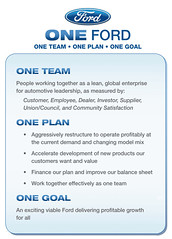At the risk of giving away too much of what we do (not really – everything we do in social media is in the public, so you just need to pay attention or search around to find out), I’d like to share with you a little bit about Ford Motor Company’s approach to social media.
Here’s a great video that WebPro News did when we were at Blog World Expo last October. It captures a lot of what Ford is doing in the space.
I keep a clipsheet of coverage of our social media efforts (using Profilactic), which is helpful when speaking to reporters or digital media and they’re looking for examples of how our work has resonated. I simply refer them to our links and they can sort through the filters to find what they’re looking for.
On his blog, Jeff Bullas gave away The 7 Secrets to Ford’s Social Media Marketing Success last month. There are some great takeaways there for any company that’s interested in social media and some that are specific to Ford and our efforts. And Slate.com’s The Big Money covered the success we’ve seen from the first wave of the Fiesta Movement.
We’re working on a lot more – notably Chapter 2 of the Fiesta Movement, in which there are 20 teams of two in 16 cities across the country, creating mini marketing campaigns through social media as well as offline events and media. And our social media strategy is global, reflecting the growing interest from many areas around the company and around the world.
And we maintain profiles on a number of social networks, including profiles on Twitter: @Ford, @FordCustService, @FordFiesta, @FordAutoShows, @FordLatino, @FordEU, @FordAPA and more. In addition, we’ve got some employees on Twitter. You can find the full list at http://twitter.com/ScottMonty/ford.
We also have a number of Facebook pages, the most prominent of which are Ford and Mustang. All of our pages are favorited on the Ford page, so you can pick which ones you’d like to become a fan of.

In addition, we’re active on Flickr for photo sharing, YouTube for videos, Plancast and Upcoming for events, Delicious for public bookmarking, and Scribd for document sharing (where we’re the #5 most followed profile). And if you’re ever in doubt where to find us, you can see our profiles on the front of Ford.com or on The Ford Story.
Lots of stuff going on right now that’s keeping us really busy. Just thought you’d like a window into what some of it is and why we’re doing it.
Scott Monty
Disclosure: http://cmp.ly/4
 We often hear of social media being equated with tools and platforms. But it’s really much more than that.
We often hear of social media being equated with tools and platforms. But it’s really much more than that.